Blast from the Past II: Doom, Duke and Deathmatch
Pete continues his exploration of '90s first-person shooters with a look at the genre's first tentative moves towards "true" 3D.
This article first appeared on USgamer, a partner publication of VG247. Some content, such as this article, has been migrated to VG247 for posterity after USgamer's closure - but it has not been edited or further vetted by the VG247 team.
The first-person shooter genre of the early 1990s had helped push gaming technology forward significantly, as we've already seen.
But there was still a long way to go before the genre would provide a truly immersive experience. Wolfenstein 3D and its contemporaries had looked good and played well, but the fact that they essentially played on a grid-based 2D map viewed from a first-person perspective became more and more apparent over time -- particularly as titles in other genres such as Ultima Underworld were starting to experiment with environments that had height as well as width and depth.
In December 1993, just one week after Apogee released sci-fi Wolfenstein successor Blake Stone: Aliens of Gold, Id Software struck back with a new game. And it would change everything.
We're Doomed!
Doom was an obvious and significant step forward for first-person perspective games. While not deviating hugely from the basic gameplay formula set in place by Wolfenstein 3D -- run through level, shoot bad things, collect good things, get to exit in one piece -- it was the new engine that truly made people pay attention.
The way Doom put its levels together was completely different to Wolfenstein, and it resulted in much more realistic environments than its Nazi-blasting predecessor. Rather than its maps being created on a flat 2D grid with all wall blocks being of uniform height, width and length, Doom's levels were created as a two-dimensional drawing made of polygons. That is to say, rather than level creators having to painstakingly place down individual blocks of walls to create an environment, Doom allowed for the creation of much larger, irregularly shaped rooms simply by drawing shapes using straight lines, and each of these walls could then have a texture applied.
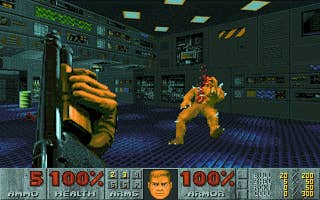
By itself, the fact that Doom allowed for irregularly shaped rooms would have made its engine distinct from Wolfenstein 3D, but the addition of height maps added further realism. No longer was a level's floor and ceiling at a constant height; now we had environments with stairs, platforms and cliffs; ditches full of toxic waste to fall into; windows that overlooked exterior areas. This didn't mark the genre becoming more platformy, however; the lack of a "jump" button meant that environments had to be designed with the player's relatively limited mobility in mind. Thus players found themselves manipulating switches to move platforms and call lifts; avoiding ceilings that rose and fall to crush them; standing atop a precarious pedestal as it rose into the ceiling, allowing for the collection of a hidden powerup.
The more complex level design allowed not only for more interesting environments to explore, but also for secrets to be hidden in more devious locations. In the case of Wolfenstein 3D and Blake Stone, secrets were always hidden behind movable sections of wall that moved two blocks back when pushed. In Doom, meanwhile, some secrets were in hidden alcoves in the wall; others required that you press a switch in one part of the level then run as fast as possible to the machinery it operated; others still demanded that you step into what appeared to be a deadly situation, only to discover that there was a tiny player-shaped hole in the ceiling big enough to fit you through.
Since they were constructed as a 2D top-down drawing -- a drawing you can see for yourself if you hit Tab in the game and look at the automap -- Doom's levels weren't true 3D, though they did a remarkable job of faking life in three dimensions. There was no means for levels to have rooms above other rooms, for example; no means for secret tunnels to pass under other pieces of floor. The levels tended to be designed in such a manner that this limitation of the engine wasn't at all obvious unless someone pointed it out to you, but it's an aspect of level design that would eventually go on to form a schism in the first-person shooter genre, with Doom's spiritual successors going in one direction and eventually hitting a dead end; the others continuing in a direction that has led us to what we know as first-person shooters today.

It wasn't just level design that set Doom apart, however; there was also the matter of weapons. While both Wolfenstein 3D and Blake Stone had featured several different weapons, most of them were simply increasingly efficient bullet delivery systems, with the exception of Blake Stone's plasma launcher, which offered an early example of a physics-based weapon.
Doom, meanwhile, offered an arsenal of weaponry that provided a variety of different means of killing opponents, and demanded that you collect the correct types of ammunition to continue using your favorite guns. Doom popularized the use of different weapons for different situations, too: shotgun for close combat; chaingun for efficiently mowing down large groups; rocket launcher for destroying powerful enemies. Those who paid for the full three-episode registered version of Doom (the fourth episode didn't come until the later "Ultimate Doom" rerelease) rather than sticking with the free shareware version also got to play with the rapid-fire plasma gun and the slow but apocalyptically powerful BFG-9000, the latter of which would become one of Id's most popular creations, referenced in one form or another in most of their future titles.
Doom also introduced -- or perhaps more accurately, if we take early titles like MIDI Maze and Maze War into account, reintroduced -- the idea of playing together with others. Initially confined to local area networks -- widespread Internet usage was still in its infancy in 1993, though a service called DWANGO eventually allowed Doom to be played online -- the game offered two modes of play: a two to four player cooperative mode, and a two to four player competitive mode called "Deathmatch," a name that is still used to describe straight-up "kill or be killed" competitive multiplayer in first-person shooters today.
Despite all these innovations Doom offered, it was actually a very different game to what designer Tom Hall originally intended. Exploring the "deleted scenes of Doom" is beyond the scope of this particular article, but as it happens Eurogamer's Joe Martin wrote a piece on this very subject a while back, so check that out if you'd like to learn more.
Apogee Rises Again
Wolfenstein's publisher Apogee wasn't resting on its laurels while the newly independent Id Software took the world by storm with Doom, though it would be a whole year almost to the day before the company would release a title that was close to being comparable to Doom in terms of technology.
That game was Rise of the Triad, which exploded onto the scene in its free shareware incarnation in December of 1994, to be followed by a commercially released registered version in February of the following year. Rise of the Triad is particularly noteworthy because it's one of several mid-'90s first-person shooters which are, at the time of writing, shortly to receive thoroughly modernized reboots.
Despite coming a year later than Doom, Rise of the Triad's engine was actually significantly more primitive than Doom's. Rather than adopting Doom's polygonal approach to level design, Rise of the Triad stuck with Wolfenstein's grid-based system, so levels were constructed out of fixed-width blocks at 90-degree angles rather than straight lines at any angle. This inferior engine technology was a side-effect of Rise of the Triad's rocky road to release -- originally intended to be a direct sequel to Wolfenstein 3D, the project was eventually revamped completely into a more modern-day setting, though some of the World War II-style weapons and enemies remained.
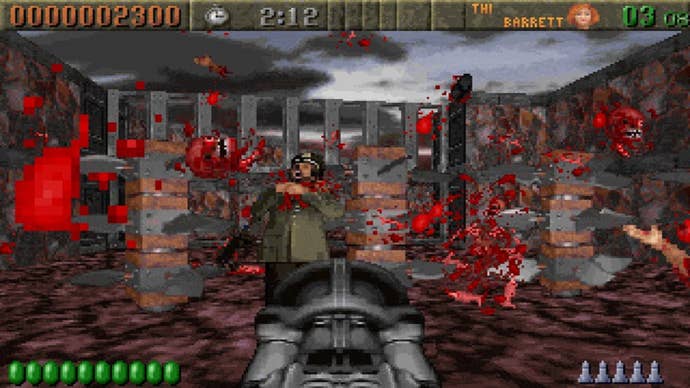
Although Rise of the Triad's core engine was fairly similar to Wolfenstein and more primitive than Doom's, it did incorporate a few obvious improvements over its predecessor. Instead of every level being the same height, for example, each level could be tall or short, allowing for anything between claustrophobic tunnels with low ceilings to exterior environments with high walls and panoramic skies. The main limitation on this engine feature, however, was the fact that the height remained constant throughout the whole level, meaning there was no sense of being in a truly 3D environment like in Doom.
Apogee's "Developers of Incredible Power," as the team behind Rise of the Triad became known, did their best to hide the shortcomings of the engine, though, by adding a number of features that hadn't been seen in other first-person shooters.
In terms of environment traversal, for example, Rise of the Triad introduced level-over-level structures through the use of sprite-based platforms the player could step on -- this allowed for a crude sense of an environment being three-dimensional by allowing the player to climb stairs and stand on floating ledges. Some Rise of the Triad levels even incorporated rudimentary platforming sequences by making these floating structures move both horizontally and vertically. Certain items also allowed you to fly, and the game was one of the first shooters to allow you to look up and down rather than straight ahead.
Rise of the Triad also brought us jumping of sorts through the use of springboards that catapulted the player into the air. These were often used to reach seemingly inaccessible locations, or simply to collect the floating "ankh" items that, paying homage to console games, would provide the player with an extra life if 100 were collected. The springboards, meanwhile, are still seen in many first-person shooter games today -- Halo multiplayer is riddled with them, for example.
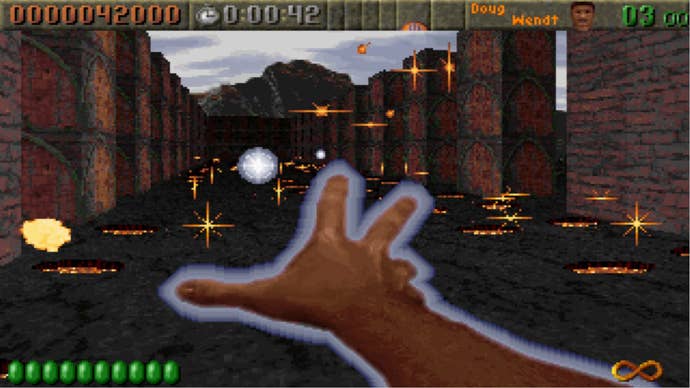
It was the weaponry and powerups that made Rise of the Triad stand out, though. While the early stages of the game went through the usual pistol-machine gun progression, pausing for the first implementation of dual-wielding pistols in a game of this type, it wasn't long before you got the first of the game's heavy weapons. These devastating rocket launchers came in several forms -- the basic bazooka simply fired a rocket forwards; the homing missile launcher tracked enemies, and the hilarious "drunk missile" launcher simply sprayed rockets chaotically all over the place, making it very dangerous to use in close quarters.
Make a bit of effort to trawl a level for secrets and you'd come across other powerups, too. In the first level of the registered version, you acquire a "God Mode" powerup that doesn't just make you invincible, it actually turns you into a god for a brief period. Your first-person perspective shifts upward, giving the impression of growing taller, and your usual weapon is simply replaced by a pointing finger that obliterates anyone who displeases you. Meanwhile, the game soundtrack becomes accompanied by some mystical chanting for the entire period you're in this form.
At the other end of the spectrum, you can turn into a dog and bark at people until they explode in a shower of intestines.
Rise of the Triad, it's fair to say, didn't take itself the slightest bit seriously -- a stark contrast to Doom, which took itself very seriously. Rise of the Triad's insistence on conforming to old-school game conventions such as having a score, lives and collectible items -- not to mention its wide array of rather silly, fun multiplayer modes -- made it feel very much like a game designed to have fun with; Doom, meanwhile, clearly aspired to something greater -- though as we've already seen, the scope of the game we eventually saw released was nothing compared to what was originally planned.
Why Do You Build Me Up, Silverman?
Eventually, Apogee became 3D Realms, and the development arm of the company accepted the fact that the way Doom handled 3D levels was, in fact, much better than the ageing, heavily modified Wolfenstein 3D engine on which Rise of the Triad was based. Thus the Build engine was born, which built upon the ideas of Doom's engine and incorporated a significant number of improvements in the process.
Build was the work of Ken Silverman, a developer who had previously dabbled in the first-person shooter market around the time of Wolfenstein with his self-named project Ken's Labyrinth -- a game that was eventually finished and released by an early incarnation of Epic. Silverman was brought on at Apogee in 1993, just before his first semester at Brown University, and he began work on the Build engine.
Build's core concept was similar to Doom's engine -- levels would be drawn in 2D but projected into 3D using height maps. In the case of Build, the 2D polygonal shapes from which the levels were constructed were known as "sectors" and given unique identifiers, and it was through this particular aspect that Build showed its biggest improvements over Doom's engine.
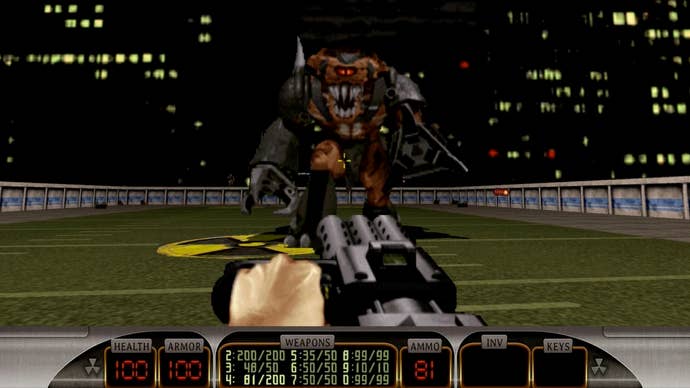
Sectors, when combined with special invisible reserved sprites called "sector effectors," allowed for the level to change its design in real time according to the player's actions. This provided the possibility of many new effects that hadn't been possible before: destructible environments, where players could blow holes in walls in certain places, and doors that pivoted around their hinges, swinging out realistically rather than using Doom's standard approach of simply rising up into the ceiling. The engine also allowed for things like swimming and going underwater -- a first for the genre.
With Build, you could also look up and down, though limitations of the 3D technology used meant that regardless of the angle you pitched your virtual head at, vertical lines always remained vertical. This meant that environments looked very distorted unless you were looking straight at them, and consequently Build games tended to be designed in such a way that looking up and down wasn't really necessary, more just something neat you could do.
Build powered a number of games over the years, including Blood and Shadow Warrior, the latter of which is soon to enjoy a remake much like Rise of the Triad. The best-known of the Build games is undoubtedly Duke Nukem 3D, however. Duke's third adventure -- his previous two had been 2D platform games -- provided a new and exciting experience in a number of ways.
Firstly, the Build engine, while not the most technologically advanced offering available at the time -- that honor went to Quake, which we'll explore in more detail in the next installment of this series -- allowed for some impressive, realistic environments. This was a fact that Duke took full advantage of with a number of levels set in "real world" locales such as cinemas, city streets and shops.
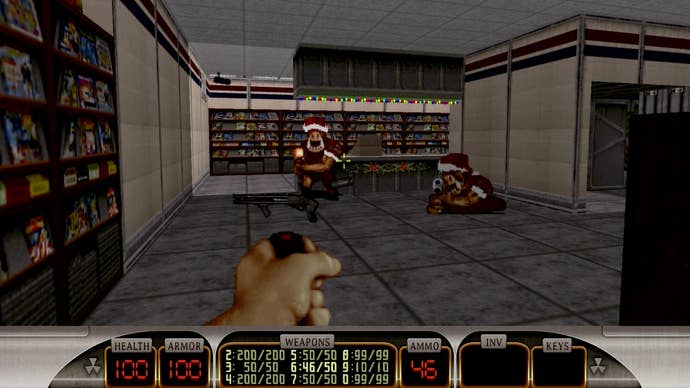
Secondly was the beginning of Duke's move into being an "adult" hero. Yes, Duke Nukem 3D marked the beginning of the series' puerile obsession with boobs, with the first level in the game being set in an adult movie theater, and subsequent levels moving through strip clubs, sex shops and numerous other "edgy" environments. As the action shifted to outer space, the "babes" who had just been standing around dancing in strip clubs were replaced with captive women stripped of their clothes and imprisoned by the alien invaders. Duke was unable to rescue them -- walking up to them simply prompted them to moan "kill me" at our hero -- but was punished with a swarm of incoming enemies if he inadvertently shot any of them.
Duke's "edginess" looks laughable -- even offensive to some -- these days, but back upon its original release, it was something of a watershed moment. This was a game that was unabashedly following the model of testosterone-fuelled action movies -- a wisecracking hero who wasn't afraid to swear; a flimsy plot; and scantily-clad women. While none of this was especially "mature," back in 1996 it was extremely rare to see anything in video games that wasn't family-friendly -- the only real "adult" content we'd seen prior to this point had related to violence.
Aside from its self-conscious (and not entirely successful) attempts to be "mature," Duke Nukem 3D was notable for a number of other reasons, chief among which was the high degree of interactivity in its environments. While Doom featured switches and secret doors, Duke took things several steps further with security cameras that could be watched through monitors and items around the level that could be used, often accompanied by a wisecrack from Duke himself. A player low on health could use a toilet, for example, with the gun dropping out of sight off the bottom of the screen as the sound of Duke relieving himself emanated from the speakers.
Rise of the Triad's powerups were also improved upon through the use of a simple inventory system, too -- now, rather than a powerup immediately being triggered upon being picked up, it could be stored for later use and unleashed at an appropriate moment. While Duke's powerups didn't feature anything as ridiculous as Rise of the Triad's God and Dog modes, the usable items added a new layer of tactical play to the genre which hadn't been seen before.
Meanwhile, on Mac...
Although the advanced technology of first-person shooters had caused a lot of people and publications to start taking home computer gaming a lot more seriously than they had in the past, most of these experiences were primarily confined to MS-DOS based PCs. Apple's Macintosh range of computers were not taken particularly seriously as potential games machines, though that didn't stop certain developers from focusing exclusively on this platform.
One such developer is an outfit you may be very familiar with already: Bungie. Yes, that Bungie. You know, the guys who made Halo.
While developers like Id and Apogee were working away on PC-centric first-person 3D engines, Bungie was doing the same on Mac. Its first game to make use of a first-person perspective texture-mapped 3D engine was called Pathways Into Darkness, but it was its spiritual successor Marathon and its two sequels that are most fondly remembered today.
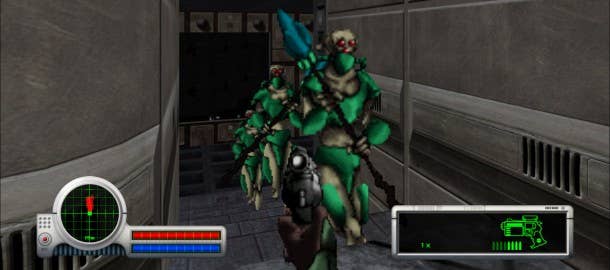
Marathon came out in December of 1994, making it a contemporary of Rise of the Triad, but often considered as the Mac's answer to Doom. The Mac desperately needed its own answer to Doom, too, since Id's classic wouldn't be ported to Apple's platform until 1995.
While Bungie's earlier title Pathways Into Darkness had been something of a survival horror adventure, Marathon was straight-up sci-fi. It wasn't just a Doom clone, though; unlike most other first-person shooter titles, which sacrificed any semblance of storytelling in favor of fast-action gameplay, Marathon placed a strong focus on its plot -- something that PC-centric first-person shooter developers wouldn't really experiment much with until Epic put out Unreal in 1998.
In Marathon, gameplay involved interfacing with the game's three AIs and discovering the unfolding plot just as much as it involved shooting aliens. This alone makes it noteworthy. While the way in which the story is told through computer terminals is fairly primitive -- some might argue first-person shooters haven't got significantly better at storytelling techniques since -- the plot itself is intricately composed. This sort of complex narrative is something Bungie would return to with the Halo series, though in that case there were two layers of plot: the simplistic action movie narrative told through the cutscenes, and the more intricate backstory woven through hidden terminals throughout the games' various levels.
Marathon's engine was roughly on a par with Build, with its levels once again based on 2D drawings projected into 3D through the use of height maps. Like Build, Marathon's engine allowed for a variety of interactive objects, and also for neat environmental effects such as being able to look through windows and see what is happening outside the titular spacecraft. Marathon also allowed players to freely look around using the mouse -- a first for the genre as a whole -- though the engine suffered from the same perspective distortion seen in Build games.
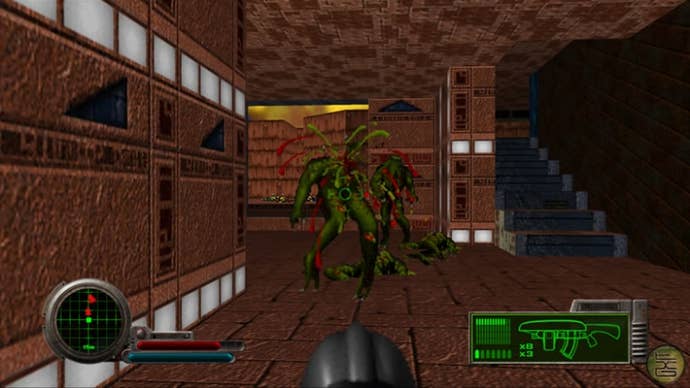
In terms of gameplay progression, Marathon broke with the normal first-person shooter format of simply requiring the player to find the exit, instead providing discrete mission objectives to be accomplished before the player would be allowed to move on. Later games in the series broke even further from this formula, ditching the linear progression altogether and allowing for the player to move back and forth between levels according to their actions.
Due to its Mac-centric legacy, Marathon's a relatively unknown title to those who primarily grew up with PC gaming. Fortunately, there are a number of ways you can familiarize yourself with this classic these days -- not only is the original trilogy available for PC for free via the Aleph One project, there are also versions available for Xbox Live Arcade and iOS. Educate yourself; while the technology may be primitive, Marathon's gameplay still holds up surprisingly well today.
Where Do We Go From Here?
Although Build and similar engines provided good-looking first-person shooter experiences, technological limitations were holding the genre back. Enemies were still sprite-based, for example, and the fact that it still wasn't possible to create a building with one room directly above another limited the potential realism possible in level design. Consequently, this particular arm of first-person shooter development eventually found itself in a dead-end, and it was its rival branch, actively seeking true 3D environments as it was, that pushed the genre onwards towards what we know as first-person shooters today.
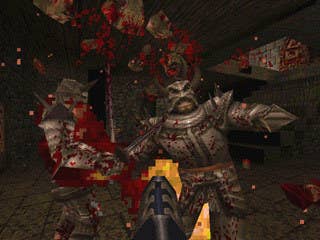
But, once again, that's a story for next time.
